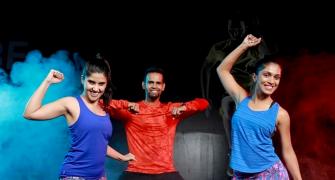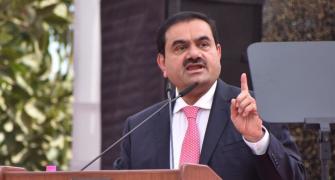India is among the top three emerging markets in the wellness economy.

A certain generation would remember the sonorous sound of the erstwhile LML scooter heralding the arrival of the rider.
The Lohia family, which had tied up with Italian auto manufacturer Piaggio in the 1980s to make the Vespa in India (Bajaj Auto had introduced it in its first avatar in the 1960s), has now added peace, pause, mindfulness and awareness to its portfolio.
With the launch of luxury wellness retreat Ekaanta in Haridwar (Uttarakhand) in September 2022, Saumya Lohia Agarwal, a third-generation Lohia entrepreneur, has entered a space that is growing.
Wellness of the mind and the body is a sphere India has long presented itself as an ambassador of.
One fallout of COVID-19 pulling the brakes on humanity has been that people now pay greater attention to health and wellness.
According to Global Wellness Institute's report on country rankings, roughly one in every 20 dollars spent by consumers worldwide is on wellness today.
And the Federation of Indian Chambers of Commerce and Industry (Ficci) estimates that an average Indian millennial now spends Rs 4,000 per month on fitness and wellness.
Given the mood, Ayurvedic products firm Baidyanath Group has also entered the arena.
Family matriarch Anuradha Sharma says the group, which is over a century old, launched a "treatment line in health and wellness with Ayurveda wellness retreat Shatam Jeeva in Jhansi last year".

India is among the top three emerging markets in the wellness economy, behind Brazil and Mexico.
The global health and wellness market, which was valued at $4.7 trillion in 2021, is projected to reach $12.9 trillion by 2031 at a compound annual growth rate (CAGR) of 10.9 per cent, according to an Allied Market Research report (Health and Wellness Market, Global Opportunity Analysis and Industry Forecast, 2021-2031) published January 2023.
"Asia-Pacific, with a large role played by India, is estimated to be the most opportunistic market during the forecast period," says Pradeep Multani, chair, Ficci AYUSH Committee.
"Of the approximately $5 trillion wellness market, India will contribute around three to four per cent by 2025. This is a huge jump from India's total contribution of less than 0.25 per cent," adds Multani.
The Global Wellness Economy report had pegged India's wellness market at $77.6 billion in 2020. India stood at the 12th spot among the top 20 markets in the world.
The wellness sector, however, presents a varied picture across countries. While China, India, Russia and Turkey stick with traditional or complementary medicine as their major spend, for Sub-Saharan Africa, the focus is on public health and prevention.
And, if the Japanese earmark a big share of their wellness purse to personal care or beauty products, Germans like to spend on wellness tourism.
The Indian players, meanwhile, look ready to awe by offering customised therapies. These include the Ayurvedic way of life, yoga, emotional healing, energy therapies, mindfulness, awareness, and promoting 360-degree wellbeing.
The global yoga market alone was valued at $37,462.5 million in 2019. Allied Market Research projects it to reach $66,226.4 million by 2027, growing at a CAGR of 9.6 per cent, with the Asia-Pacific region expected to grow the most -- at 10.8 per cent.
Niraamaya Wellness Retreats, one of the largest such providers in southern India, will soon be opening doors to a complete wellness village: Vaidekam Ayurveda Healing Village.
Meanwhile, Hollywood and other A-listers' favourite, Ananda in The Himalayas, is integrating Ayurveda, yoga, emotional healing, hypnotherapy, traditional medicines, psychotherapy, and more, all customised to an individual's healing journey and requirements.
Apart from the existing panchakarma (cleansing the body of unwanted waste), sattvic diet and spiritual therapies, Shatam Jeeva intends to introduce Ayurvedic beauty-health therapies.
Think 'rajrani snanam', a bath with raw milk infused with rose petals coming from a 1,000-hole earthen pot.
"The best thing about Ayurvedic treatments is that there are no side effects, and as a person starts getting better, the beauty and glow is just a given, along with a happy state of mind," says Sharma.
Adds Lohia Agarwal, "Since conceptualising Ekaanta in 2019, it took us almost three years to finalise our curriculum. We are now teaching people the importance of peace, pause, mindfulness, and awareness by combining teachings from ancient saints and modern science."
The retreat is projected as 'Mindversity on the Ganges'.
Mahesh Natarajan, chief operating officer at Ananda in the Himalayas, speaks of their guests' significant shift in preference from merely leisure to integrated wellness.
"There is definitely a renewed sense of commitment when it comes to personal wellbeing and coping mechanisms," he says.
"If earlier our international guests would mostly opt for a week-long stay, now they are staying for 10-15 days."
A similar shift towards sustained wellbeing is visible among its domestic guests too, with Ananda recording an overall growth of 47 per cent in its Indian business post the pandemic.
Post-pandemic, health and wellness are clearly being viewed as a way of life, and not something to be focused on only in the time of illness.

Feature Presentation: Ashish Narsale/Rediff.com










